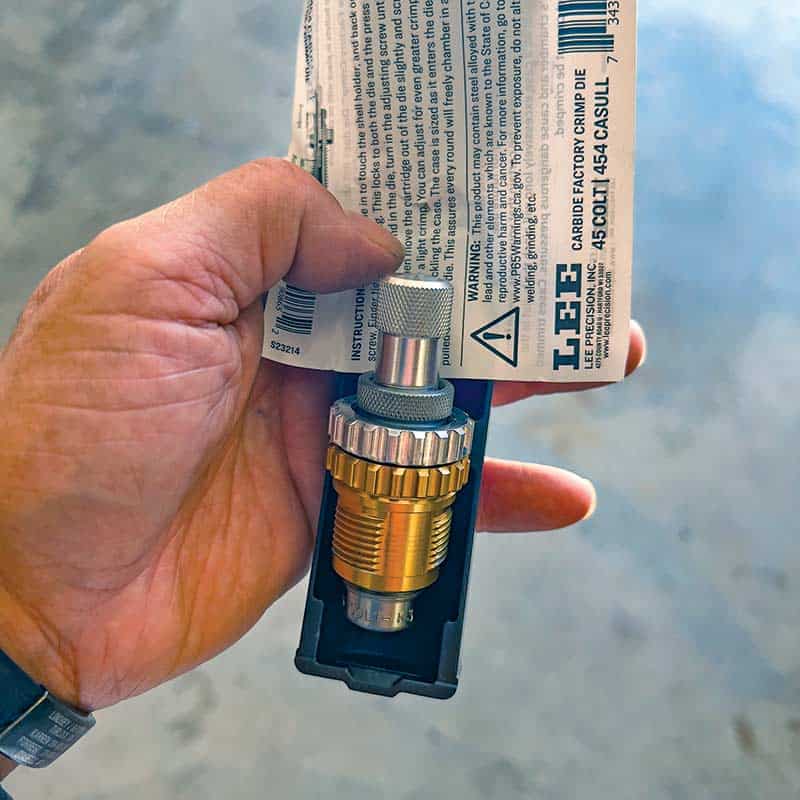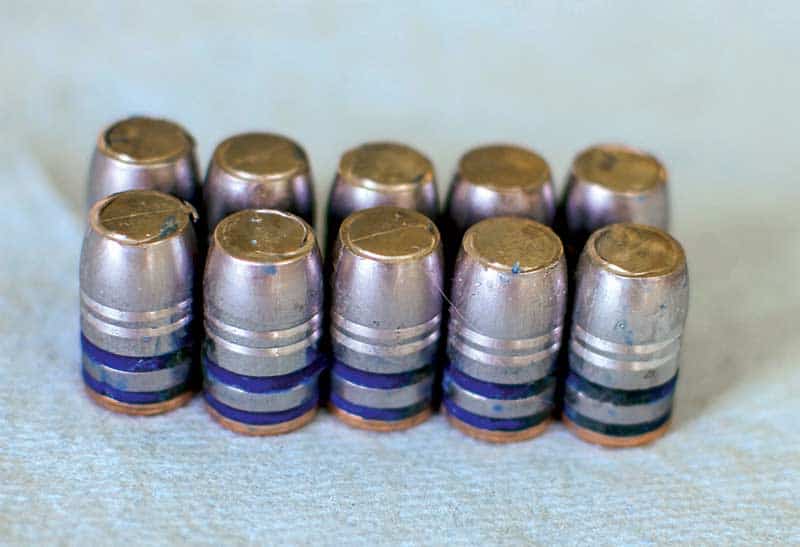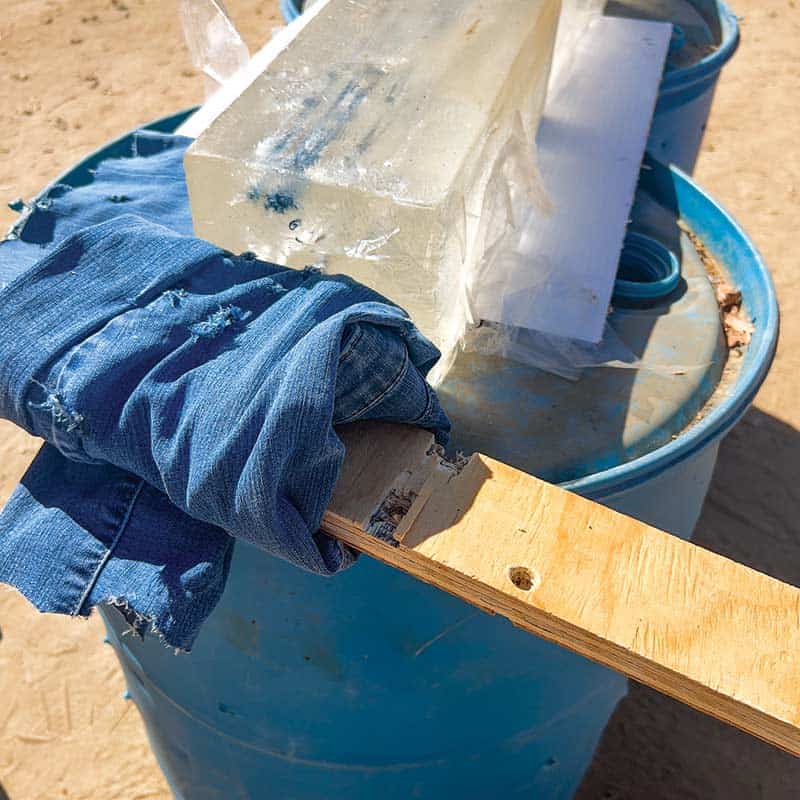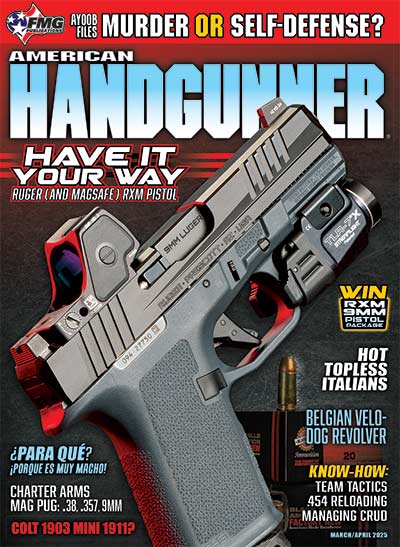.454 Casull Penetration
"Light" Big Handloads
Once, while cross-country skiing in Yellowstone, I was following the ski tracks of the local biologists, who were monitoring bear hibernation activity. I figured the bears were all sleeping, so I was good, at least until huge paw tracks began crisscrossing the ski tracks.
I know little about defending myself against large creatures, but as a reloader, I know your best bet is a heavy bullet with a generous meplat. The goal is not expansion but penetration. I set out to design some loads that had accuracy and softer recoil for follow-up shots.
I picked the Lee 452-300-RF six-cavity gas check mold. I use Sage’s Outdoor gas checks because I can pop them on before sizing, and they stay on. I sized these bullets at 0.452″ and used Carnauba Blue lube from LSStuff.com.
Loading Details
I did a little homework, and one point is consistent: Crimp is your friend. For those who don’t play with heavy recoil, crimp jump is a real thing. This happens when the rearward thrust from a gun’s recoil pulls the bullets out of their crimp.
I settled on a Lee Factory Crimp Die for .454 Casull. This die is unique because it uses a carbide ring to size the cartridge and keep the crimp concentric. You heard correctly: This die re-sizes the case after bullet seating. Usually, .454 chambers have tight tolerances. This die ensures the cartridges will chamber.
My setup for reloading the .454 is the Lee 40th Anniversary Challenger Press, using their new Breech Lock Dies. The Lee Challenger Press has the Lee Lever Prime System, which is an ingenious metal piece that balances in the machined cuts in the ram. For single-stage priming, it is the simplest and fastest method to get consistently seated primers.
Charging
I was looking for moderate pressures and started with Lovex Buffalo Rifle. This generally gives reduced recoil in the .45 caliber straight-walled cartridges in reduced loads. For the .454, loads over 90% capacity with 300-grain bullets are still “light” loads.
In my experience, I can load most straight-walled cartridges to capacity and still run at moderate pressure. For the .45 family of cartridges, this is almost the rule. Twenty-five grains of Buffalo Rifle pushed the 300-grain gas check bullet at an average of 1,100 fps.
The .454 Casull cartridges need the thicker cup of a rifle primer, and enough of a spark to consistently ignite the load. I used CCI 450 Small Rifle Magnum primers.
Testing
I used a 1″ piece of exterior plywood and four layers of denim to simulate bones and hide and backed this with ballistic gelatin. After the plywood and denim, the bullet continued into 41″ of ballistic gelatin.
After a while, I ran it up to 26 grains, which averaged 1,185 fps. In an S&W 460 460XVR with a 7.5″ barrel, it barely raised the barrel off the shooting rest. It felt like a 9mm. Eventually, I moved over to my Ruger Alaskan, with a 2.5″ barrel. Even in the lighter gun, follow up shots were possible.
Before you think, “That’s not very hot for a .454 Casull,” let me point out that this is the purpose of this endeavor. Some of the hottest .44 Magnum loads run 1,400 fps with 225 grains or about 980 foot pounds of energy. The 10mm loads can push 200 grains to 1,100 or so fps., or about 550 FPE. Most of the light loads I tested exceeded 1,000 foot pounds.
More Juice
Buffalo Rifle did the trick for soft, low-pressure shooting, but it barely crested 1,200 fps with a full case. I could place the 452-300-RF bullets within 4″ at 25 yards, regardless of the load. This was good, but I knew I needed something with a little more sauce.
I began using 3N37. I started with 15.0 grains and increased the load incrementally. The groups tightened up at 15.3 grains, which averaged 1,307 fps. This was more like it. It dramatically splintered the plywood and sped through 48″ of gelatin, striking the backstop of our range. The S&W 460XVR with a 7.5″ barrel was printing headshots at 25 yards. At 15.6 grains, I averaged 1,340 fps, with a very low SD. This is 1,196 FPE. The 450XVR effortlessly spat the 300-grain pills out, and I was practically running a clinic on soft-shooting monster killers.
The empty brass extracted as if they were lubricated, and they were less stressed when sizing. I’m pretty sure there are experts out there who know that the more powerful, the better. However, the cartridge I have been loading exceeds the hottest .44 magnum performance by far, which is why the .454 Casull was designed in the first place.







